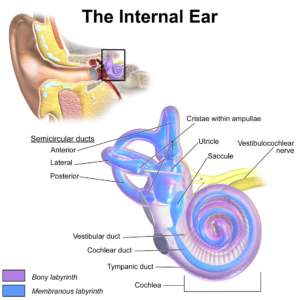Balance and coordination are vital in daily living, from stepping out of bed in the morning to laying back down of a night, the importance of knowing which way is up and which way is down allows you to get on with your day. Regularly in the clinic we talk about the importance of balance and coordination as part of rehabilitation. But what is Balance?
You may have heard that your balance is controlled in your inner ear, well you’re close but not quite right. Our balance is maintained by an impressive interaction and interpretation of sensory information within the brainstem. The sensory input comes from 3 main sources; the inner ear (peripheral vestibular system), your visual input (eyes) and proprioceptive input (muscles, joints, ligaments, tendons).
Our peripheral Vestibular system is made up of the inner ear and the nerve that connects the inner ear to the brainstem. The inner ear/vestibular system provides sensory information about motion, equilibrium and spatial orientation.
Each ear has identical vestibular organs, when these organs on both sides of the head are functioning properly, they send symmetrical impulses to the brain which is coordinated with the visual and proprioception sensory input.
If you refer to the image you will see a diagram of the inner ear anatomy.
The Urticle and Saccule provide information to the brain about head position when it is not moving. The utricle detects linear accelerations and head-tilts in the horizontal plane.
Whereas the Saccule detects information about linear movement in the vertical plane.
Next thing to find on the diagram are the semi-circular canals, which are made up of 3 canals that detect rotational movement of the head. Receptors within these canals send information to the brain where this information is interpreted to assist with head position and orientation.
The next component to balance and control is Proprioception. Proprioceptive input is sensory information which provides the brain with information of body position, and movement. The sense of relative joint position in relation to another body segment is provided by sensory nerves and specific proprioceptive
Proprioception is mediated by proprioceptors – which are mechanosensory neurons located within the muscles, tendons, ligaments and joints. There are many types of proprioceptors, which are continually providing your central nervous system information on body position, movement, velocity of movement, load on a limb, etc.
The final and a very large component of balance is visual input. You will notice this when you stand on one leg then close your eyes, you will struggle to stand. This is because our brain is continually providing feedback between our vestibular system and eyes.
In my following blogs I will be discussing the vestibular system further, taking a deeper look at into conditions of the vestibular system that we treat in physiotherapy.
If you are experiencing any issues with your balance, a Physiotherapy Assessment with one of our Bend + Mend Physios will be greatly beneficial.
Image sourced from: Blausen.com staff (2014). “Medical gallery of Blausen Medical 2014“. WikiJournal of Medicine 1 (2). DOI:10.15347/wjm/2014.010. ISSN 2002-4436.






